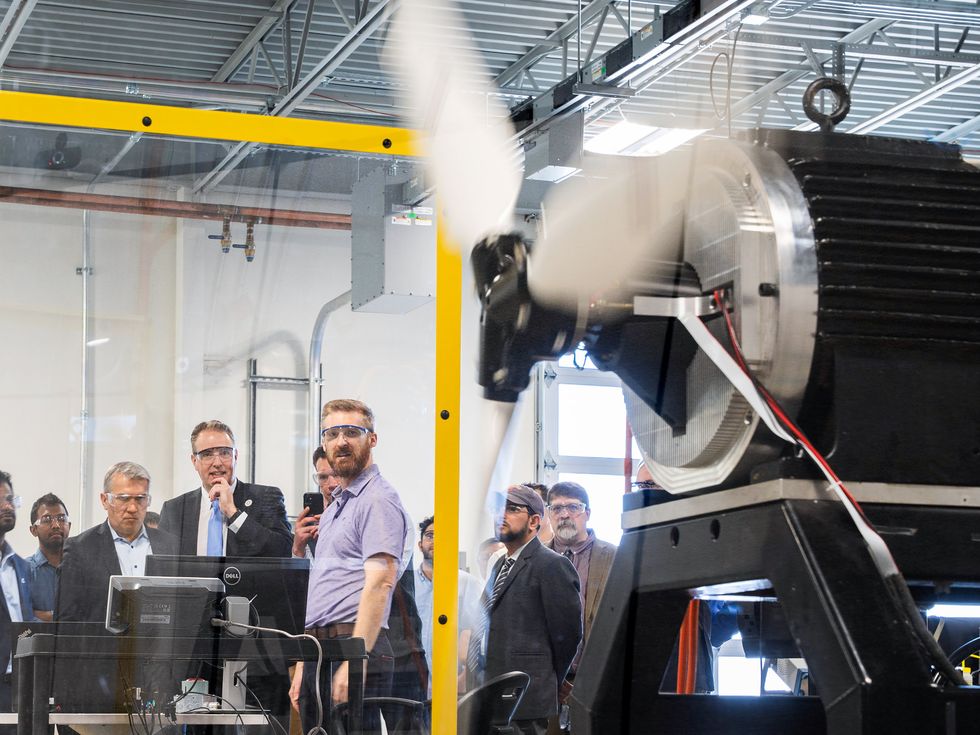Now Reading: Superconducting Motor Could Propel Electric Aircraft
-
01
Superconducting Motor Could Propel Electric Aircraft
Superconducting Motor Could Propel Electric Aircraft

Of the countless technologies invented over the past half century, high-temperature superconductors are among the most promising and yet also the most frustrating. Decades of research has yielded an assortment of materials that superconduct at temperatures as high as -140 °C (133 kelvins) at ambient pressure. And yet commercial applications have been elusive.
Now, though, a couple of developments could finally push high-temperature superconductors into commercial use. One is the availability, at relatively moderate cost, of copper-oxide-based superconducting tape, which is being produced by a few companies for startups working on tokamak fusion reactors. The reactors use the superconducting tape, which is typically made of yttrium barium copper oxide, in powerful electromagnets. The other development involves a different group of startups that are using the tape to build electric motors with very high power-to-weight ratios, mainly for use in electric aircraft.
Among that latter group of startups is Hinetics, formed in 2017 to commercialize research led by Kiruba Haran at the University of Illinois Urbana-Champaign. This past April, the company tested a prototype motor outfitted with superconducting rotor magnets. According to Haran, the tests, which included spinning a propeller in a laboratory setup, validated key components of the company’s designs for superconducting motors that will operate at power levels of 5 and 10 megawatts. Such levels would be high enough to power a regional passenger airliner with multiple motors. The work was funded in part by a grant from the Advanced Research Projects Agency–Energy (ARPA-E).
“HTS [high temperature superconductors] are having a moment, because the costs are coming down rapidly, driven by all the work on fusion,” Haran says. “A lot of people are ramping up production, and new startups, and new capabilities, are coming into the market.”
Hinetics is one of perhaps a dozen companies, large and small, trying to use high-temperature superconductors to build extremely efficient motors with very high power density. These include aerospace giant Airbus, which is working on a superconducting airliner under a program called ZEROe, as well as Toshiba, Raytheon, and U.K. startup HyFlux. However, Hinetics is taking an unusual approach.
Common approaches to building a superconducting machine use the superconducting material for either the rotor or stator coils, or both. Typically, the coils are cooled with a liquid or gas kept at a sufficiently low temperature by an external cryocooling system. The fluid cools the superconducting coils by convection, by physically flowing through heat exchangers in contact with the coils and carrying away heat as it does so. The system has been used successfully in some experimental motors and generators, but it suffers from several fundamental problems. A big one is the need to circulate the cooling fluid through the rotor coils, which are embedded in a rotor assembly that is spinning at perhaps thousands of revolutions per minute. Another problem is that this approach requires a complicated cryocooling system that includes pumps, seals, gaskets, pipes, insulation, a rotary coupling that transfers the cryogen into and out of the rotor, and other components that can fail and that add considerable weight.
 The rotor coils in an experimental Hinetics electric motor are made of a high-temperature superconductor. They are cooled by a cryocooler that runs axially down the center of the motor. The rotor assembly and the cryocooler are enclosed within a vacuum vessel.Hinetics
The rotor coils in an experimental Hinetics electric motor are made of a high-temperature superconductor. They are cooled by a cryocooler that runs axially down the center of the motor. The rotor assembly and the cryocooler are enclosed within a vacuum vessel.Hinetics
Hinetics’s Revolutionary Idea: Spin the Cryocooler
Hinetics’s system, on the other hand, uses a self-contained cryocooler that is small enough to be attached to the rotor, and which spins along with it, eliminating the need to pass fluids into and out of a spinning vessel. With this arrangement, “you don’t have to immerse the superconductor into the fluid,” notes Laurent Pilon, an associate director for technology at ARPA-E. Instead, “there’s a cryocooler, and a cold connection, and you pull out the heat from the superconducting magnetic coils to the cryocooler, performing a refrigeration cycle. The beauty here is that it simplifies everything because now you just have the cryocooler that spins with the shaft.”
In this configuration, the rotor assembly, including the coils, is cooled by conduction rather than convection. The rotor is installed within a vacuum chamber. Heat from the superconducting magnet assembly is transferred through a “thermal bus,” which is basically just a disk-shaped copper structure that conducts the heat to the cryocooler, which is attached to the other side of the copper disk.
One of the challenges, Haran says, was finding a cryocooler small and light enough to spin at high rates and keep functioning while doing so. For its proof-of-concept unit, the Hinetics team used an off-the-shelf Stirling-cycle cooler from Sunpower. It can remove only 10 watts of heat from the rotor assembly but, in this configuration, that’s all that’s needed to keep the rotor coils superconducting, Haran says.
One potential drawback of the system is that, because of this relatively low heat-removal capacity, the cryocooler takes a few hours to cool the superconducting magnet sufficiently to start operating. Future versions will reduce the period needed, according to Haran. And on the bright side, the low heat-removal rate means high efficiency, because the cooler has just enough power to maintain the low temperatures needed during operation, and not much excess capacity.
To provide electric power to the spinning cryostat and rotor magnets the prototype used a slip ring. But future versions of the motor will use a wireless system, possibly based on inductive coupling, Haran says.
 Tests of Hinetics’s superconducting motor this past April validated the basic design and cleared the way for construction of more powerful units.Hinetics
Tests of Hinetics’s superconducting motor this past April validated the basic design and cleared the way for construction of more powerful units.Hinetics
Applications on Ships Are Also Possible
He opted not to make the stators superconducting, because in a typical configuration the stator is energized by an alternating-current (AC) waveform. Superconductors are only completely lossless for direct current. So the application of AC to superconducting coils in the stator would result in power losses that would require another cooling system to remove heat from the stator.
Haran figures it’s not necessary. With superconductors just in the rotor coils, the motor will achieve efficiencies in the range of 98 to 99.5 percent, which is about four or five percentage points higher than what is realistically possible with a permanent-magnet synchronous motor. Haran also insists that the superconducting design would attain this high efficiency without any reduction in power density, a combination that’s hard to achieve in a conventional motor.
Four or five percentage points might not seem like a lot, but it would matter in typical aviation applications, Pilon says, especially when coupled with higher power density. On its website, Hinetics claims that its motor has a continuous specific power of 10 kilowatts per kilogram, which would put the machine among the most power-dense units available, on a continuous-power basis. According to Haran, the next generation of the superconducting motor will achieve 40 kW/kg, which would be far higher than anything commercially available.
Although aviation is the initial target, Haran sees potential applications in ship propulsion, where the motor’s high volumetric power density would be a draw. “What’s really exciting is that we are seeing a transformational new technology become practical,” he says. “Once you get to megawatts and low speed, anywhere you need high torque, this could be very interesting.”




















